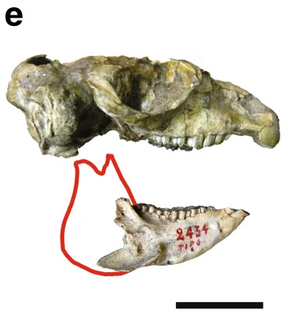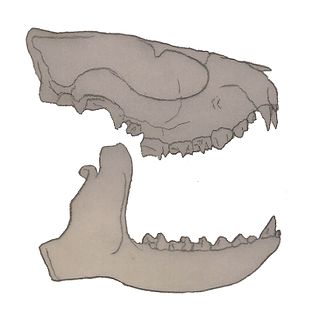
Carodnia is an extinct genus of South American ungulate known from the Early Eocene of Brazil, Argentina, and Peru. Carodnia is placed in the order Xenungulata together with Etayoa and Notoetayoa.

Agriochoerus is an extinct genus of scansorial herbivore of the tylopod family Agriochoeridae, endemic to North America. Agriochoerus and other agriochoerids possessed claws, which is rare within Artiodactyla, as well as likely being scansorial. Agriochoerus was first described in 1869.

Albertogaudrya is an extinct genus of astrapotherian mammal that lived in present-day Salta, Argentina during the Eocene 48.6 to 37.2 million years ago. Fossils of Albertogaudrya have been found in the Lumbrera and Sarmiento Formations. It is named after French palaeontologist Albert Gaudry.

Didolodontidae is a family of "condylarth" mammals known from the Paleocene to the late Eocene of South America.

Astraponotus is an extinct genus of herbivorous mammals, belonging to the family of astrapotherids. It lived during the late Late Eocene and its fossil remains have been found in the Sarmiento Formation of Argentina, South America.
Utaetus is an extinct genus of mammal in the order Cingulata, related to the modern armadillos. The genus contains a single species, Utaetus buccatus. It lived in the Middle to Late Eocene and its fossil remains were found in Argentina and Brazil in South America.
Cocatherium is an extinct genus of marsupial mammals of uncertain family placement, from the earliest Paleocene of South America, predating the Tiupampan South American land mammal age. The genus was described based on a fossil molar that was found in the Danian part of the Cretaceous-Paleogene Lefipán Formation in the Cañadón Asfalto Basin in north-central Patagonia, Argentina. The type species of the genus is C. lefipanum.
The Geste Formation is a fossiliferous geologic formation of the Puna Plateau in the western Salta Province and northern Catamarca Province of the Argentine Northwest, northwestern Argentina.

Gypsonictops is an extinct genus of leptictidan mammals of the monotypic family Gypsonictopidae, which was described in 1927 by George Gaylord Simpson. Species in this genus were small mammals and the first representatives of the order Leptictida, that appeared during the Upper Cretaceous.

Paedotherium is an extinct, potentially paraphyletic genus of Notoungulate, belonging to the family Hegetotheriidae, composed of small-sized, rodent or lagomorph-like South American ungulates. Four species are unambiguously recognized, from the Late Miocene to the Pleistocene of Argentina, and from the late Miocene of Bolivia and Chile.
Megadolodus is an extinct genus of Proterotheriidae, an extinct family of ungulates native from South America (Meridiungulates), belonging to the order Litopterna.

Tremacyllus is an extinct genus of Notoungulate mammals, belonging to the Typotheria suborder. It lived from the Late Miocene to the Early Pleistocene and its fossilized remains were discovered in South America.
Ernestokokenia is an extinct genus of mammal, belonging to the Didolodontidae. It lived during the Early Eocene and the Middle Eocene, and its fossils were discovered in South America.
Lamegoia is an extinct genus of mammals, belonging to the family Didolodontidae. It lived during the Late Paleocene in what is now South America.
Paulogervaisia is an extinct genus of mammal, belonging to the family Didolodontidae. Its fossilized remains have been found in South America.
Notoetayoa is an extinct genus of mammal, from the order Xenungulata. It lived during the Middle Paleocene, and its fossilized remains were discovered in South America.

Eoastrapostylops is an extinct genus of herbivorous mammal, who lived during the Late Paleocene in what is now South America.
Carolozittelia is an extinct genus of mammals, belonging to the order Pyrotheria. It lived during the Early Eocene, and its fossilized remains were found in South America.
Propyrotherium is an extinct genus of mammals, belonging to the order Pyrotheria. It lived during the Late Eocene, in what is now South America.
Astrapothericulus is an extinct genus of mammals, belonging to the order Astrapotheria. It lived during the Lower Miocene in what is now South America.

















